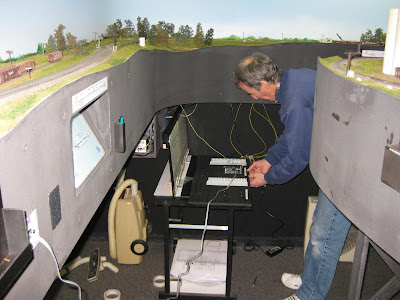Many years ago I had the privilege of operating on a large BN N Scale layout housed in a basement in Kansas. To be able to run your train and have a dispatcher controlling the movement of all of the trains on the main line was a lot of fun and frankly I never thought I would ever get that far.
Moving to DCC back in 2009 and having my tortoise motors controlling the aspects on the signals made by my good friend Vic on my RR was as far as I dared to dream.
The 13th National N Scale Convention (of which I was on the committee) was due to be held in April of 2013 and whilst enjoying a morning cup of tea with my good wife we were talking about what was next on our hobby agenda's. She is into scrap booking and card making so she had a great list of wants. I mentioned that I was still thinking about moving to a full signalling system as we were having issues of head on's during operating sessions between towns. To my complete surprise she said how much should it cost and if not too much well lets see how we go.
Man was that a great go ahead. Straight away a call to one of our good friends Brendan to see if he could work up a budget to get signalling and dispatching up and running before the convention by this time only seven months away. That budget came back almost immediately from Brendan
and with a bit of thought we decided that it should go ahead.
Brendan set too and drew up a schedule of what was really needed and what I should order first. Orders for 2 BDL168's ( later another was added) and 4 SE8C boards were placed along with 4 sets of Digitrax ribbon cable and clips.
Another email to the two electrical guys on the list John F and John C to see if they were up to a big task and the responses in the affirmative were back within the hour.
Brendan supplied all of the drawings that he had worked up from my track plan once we marked up where all of the sticks were and on what OGCB's they were to tell us what block wire needed to go where.
So on October 1st 2013 work commenced. I removed all of the fascias to make it easier to get to the track feeders, signals and tortoise motors. Vic set to to make some additional signals for areas where there were none, rolls of heavy gauge wire were purchased along with a large amount of terminal strips. Once the signal parts arrived John C took the BDL168's that I had mounted to boards home to wire the terminal strips to them so we could remove them if needed.
 |
| Supplies ready to be used. |
 |
| Wiring commences |
 |
| Testing the BDL's |
 |
| Wiring into the BDL's terminal strips |
 |
| The BDL168's are mounted with terminal strips next to the Digitrax command station |
 |
| First two mounted and connected to the blocks |
The next task was to test the whole system and once a small issue was sorted out it all worked.
During rest days (we only worked two days a week) I went about purchasing the monitors, monitor stands a dispatchers desk albeit broken for a very cheep price and a chair oh and lots more cable.
The next task was to make up the small Printed circuit boards so we could attach the signal wires from Vics signals including resistors.
 |
| two of my very happy helpers John C and John F. thanks lads. |
 |
| Just a few of the many.PCB required |
 |
| They work! |
Wiring the SE8C's was next on the agenda and as these were going to be mounted under each peninsular they had to be mounted on a backboard then wired to terminal strips like the BDL's.
As there were 4 of these required John C took these home once I had mounted them again for pre wiring. This made progress go quickly once mounted under the layout as I was able to run the ribbon cable as per Brendan's drawings once the two Johns had determined which colour went where.
The dispatchers desk was repaired, monitors mounted and as we made progress to the layout, Brendan 50 kilometers away was sending emails with the software required to get the ABS signalling system up on the screens. I would download it to a USB stick download it to my signalling computer and then as updates came in just repeated the process. Brendan did a fantastic job and still is today as we move towards a full CTC system.
 |
| Brendan has been able to get my track plan spread over the two screens and massage it to my liking |
 |
| We needed to add the DS54 to get more detection for the town of Augusta. |
We are now into January 2013 just three and a half months after starting this project and the very first full operating session with ABS took place. A huge thank you to all of my friends who without their full support this task could not have even started.
.jpg) |
| Noel is missing as he took this image That's me sitting |
Thanks for taking an interest in the Santa Fe Railway Southern Division.
Rod.










